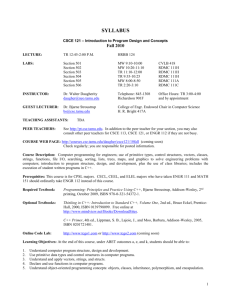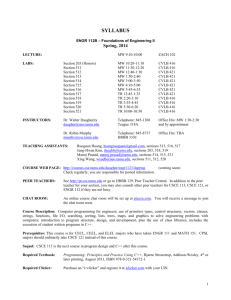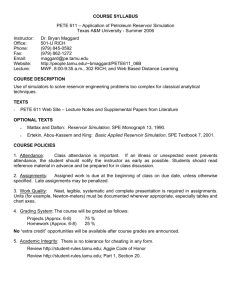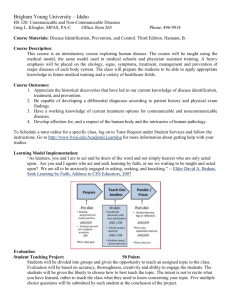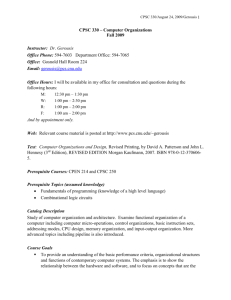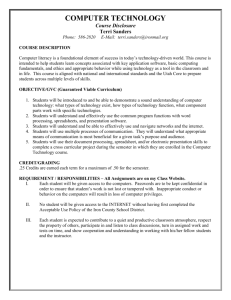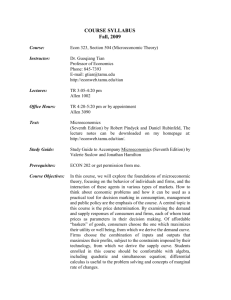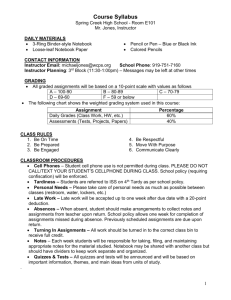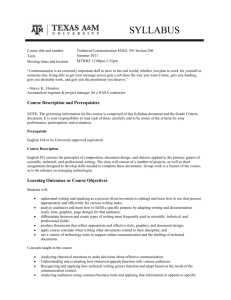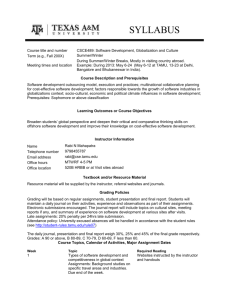syllabus_112B_07a_revision1 - CS Course Webpages
advertisement
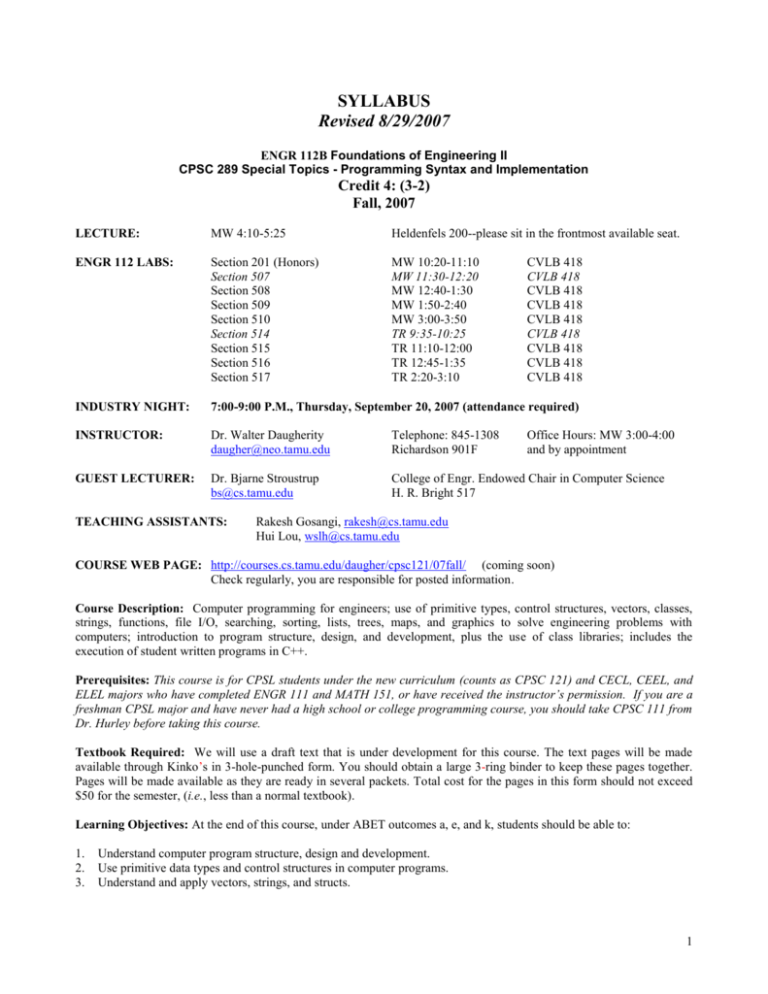
SYLLABUS Revised 8/29/2007 ENGR 112B Foundations of Engineering II CPSC 289 Special Topics - Programming Syntax and Implementation Credit 4: (3-2) Fall, 2007 LECTURE: MW 4:10-5:25 Heldenfels 200--please sit in the frontmost available seat. ENGR 112 LABS: Section 201 (Honors) Section 507 Section 508 Section 509 Section 510 Section 514 Section 515 Section 516 Section 517 MW 10:20-11:10 MW 11:30-12:20 MW 12:40-1:30 MW 1:50-2:40 MW 3:00-3:50 TR 9:35-10:25 TR 11:10-12:00 TR 12:45-1:35 TR 2:20-3:10 INDUSTRY NIGHT: 7:00-9:00 P.M., Thursday, September 20, 2007 (attendance required) INSTRUCTOR: Dr. Walter Daugherity daugher@neo.tamu.edu Telephone: 845-1308 Richardson 901F GUEST LECTURER: Dr. Bjarne Stroustrup bs@cs.tamu.edu College of Engr. Endowed Chair in Computer Science H. R. Bright 517 TEACHING ASSISTANTS: CVLB 418 CVLB 418 CVLB 418 CVLB 418 CVLB 418 CVLB 418 CVLB 418 CVLB 418 CVLB 418 Office Hours: MW 3:00-4:00 and by appointment Rakesh Gosangi, rakesh@cs.tamu.edu Hui Lou, wslh@cs.tamu.edu COURSE WEB PAGE: http://courses.cs.tamu.edu/daugher/cpsc121/07fall/ (coming soon) Check regularly, you are responsible for posted information. Course Description: Computer programming for engineers; use of primitive types, control structures, vectors, classes, strings, functions, file I/O, searching, sorting, lists, trees, maps, and graphics to solve engineering problems with computers; introduction to program structure, design, and development, plus the use of class libraries; includes the execution of student written programs in C++. Prerequisites: This course is for CPSL students under the new curriculum (counts as CPSC 121) and CECL, CEEL, and ELEL majors who have completed ENGR 111 and MATH 151, or have received the instructor’s permission. If you are a freshman CPSL major and have never had a high school or college programming course, you should take CPSC 111 from Dr. Hurley before taking this course. Textbook Required: We will use a draft text that is under development for this course. The text pages will be made available through Kinko’s in 3-hole-punched form. You should obtain a large 3-ring binder to keep these pages together. Pages will be made available as they are ready in several packets. Total cost for the pages in this form should not exceed $50 for the semester, (i.e., less than a normal textbook). Learning Objectives: At the end of this course, under ABET outcomes a, e, and k, students should be able to: 1. 2. 3. Understand computer program structure, design and development. Use primitive data types and control structures in computer programs. Understand and apply vectors, strings, and structs. 1 4. 5. 6. 7. 8. 9. 10. 11. Declare and use functions in computer programs. Understand object-oriented programming concepts: objects, classes, inheritance, polymorphism, and encapsulation. Design and create simple graphic user interfaces. Understand and apply file I/O in computer programs. Understand and use basic algorithms for searching, sorting, lists, trees and maps. Navigate and make use of class libraries. Write simple computer programs in a high-level programming language, C++. Complete a team design project using knowledge and principles from the course. Learning objectives 1 through 10 will be assessed using homework, quizzes and exams. Objective 11 will be assessed by evaluating student group programming projects and written reports. CPSC 289, Special Topic Course: Programming Syntax and Implementation must be taken in conjunction with ENGR 112 to add the class and lab time necessary to accomplish the full set of learning objectives. The combination of ENGR 112 and CPSC 289 is one 4-hour course and you will receive the same grade in ENGR 112 (for 2 hours) and CPSC 289 (2 hours). Method of Evaluation: Lab Work (Labs, Quizzes, Papers) One-hour Exams (2) (10 pts each) Comprehensive Final Exam Project Attendance and Class Participation (Pop quizzes and lab quizzes) 30 20 25 20 5 % % % % % Grade Scheme 90 - 100 A 80 - 89 B 70 - 79 C 60 - 69 D < 60 F GRADING POLICIES: Attendance: Lecture and lab attendance is expected. Infrequent unavoidable absences are understood, but each student is responsible for any missed material. For excused absences, students will not be penalized. See Section 7 of the Student Rules for the excused absence policy. For acute illnesses of less than three days, both option A and option B of section 7.1.6.2 are acceptable in this course. For unexcused absences, a grade of zero will be assigned for missed work. Class Participation: Class participation will consist of attendance (in lecture and lab) and responses to short quizzes during lecture and lab meetings about the reading assignments and the lecture. Lab Work: Submit lab assignments through CSNET (the departmental electronic turn-in system) and printouts to your assigned Teaching Assistant (TA). A text file (.txt) may be required for answers to non-program questions, explanations, or data. Each student should maintain backup copies of all work. Some lab quizzes will consist of short programming tasks, which will be performed during the lab and submitted to the TA for grading. Late Work: Homework assignments which are submitted up to 2 working days late may be penalized 20%. Assignments more than 2 working days late will not be accepted without specific approval from the instructor. Labs submitted by web, e-mail, or any form other than through CSNET, unless approved in advance by your TA or the instructor, will not be accepted. Exams: Examinations will require the use of Scantron forms, 8½ by 11 inches, gray, from Measurement and Research Services; these will be supplied by the College of Engineering, so you do not need to purchase any. Missed exams will be rescheduled without penalty for an excused absence, or with a 20% penalty if the absence is not excused. Project: A group project will be assigned to groups of 4 or 5 students each. Assignments to groups will be made by the instructor. Mid-term grades: Midterm grades will be assigned to all students in week 8, and reported to the Office of the Registrar for students who have completed less that 30 hours of college work. You must keep track of your own grades from the papers handed back. Quibbles: Grades may be appealed to the instructor using a “quibble form” available on the course web site. 2 3 American with Disabilities Act (ADA) Statement: The Americans with Disabilities Act (ADA) is a federal antidiscrimination statute that provides comprehensive civil rights protection for persons with disabilities. Among other things, this legislation requires that all students with disabilities be guaranteed a learning environment that provides for reasonable accommodation of their disabilities. If you believe you have a disability requiring an accommodation, please contact the Department of Student Life, Services for Students with Disabilities, in Room 126 of the Koldus Building or call 845-1637. STUDENT RULES: You are responsible for complying with all provisions of the student rules posted at http://studentrules.tamu.edu. SCHOLASTIC DISHONESTY: Scholastic dishonesty will not be tolerated. Working together on homework assignments is encouraged, but the final product submitted for grade must be the individual work of the person turning it in. In other words, it is all right to discuss and to assist each other concerning programming strategy or technique or for one student to help another debug code which will not work; but each student is expected to write his or her own programs from beginning to end. In this regard, if code from two or more students is essentially identical, and it is determined to the satisfaction of the instructor that the code is not the product of the individual, all students involved are subject to the Texas A&M University Honor System Rules, including a course grade of F* (* = for academic dishonesty) if this is the first offense, plus additional penalties as determined by the Aggie Honor System Office if this is not the first offense. It is imperative that each student clearly understand those rules and the serious consequences that can result from adjudication of an Honor Code Violation. In particular, every student should understand that complicity – helping or attempting to help another student commit an act of academic dishonesty also constitutes academic dishonesty and carries the same punishment as cheating. In other words, if you provide your solution to another student, who turns it in for credit, you are both subject to the same consequences. Plagiarism is the presentation of the work of someone else without giving him or her due credit. You can copy the words of others as long as you clearly identify them as such. In fact, documented use of program libraries is encouraged. Submitted work will be examined for plagiarism using computer software designed for that purpose. Examinations are meant to measure the knowledge or skill of each individual, so giving or receiving unauthorized assistance during tests and quizzes is cheating. It is assumed that college students know what is honest and what is not. Academic Integrity Statements: AGGIE HONOR CODE: "An Aggie does not lie, cheat, or steal or tolerate those who do." Upon accepting admission to Texas A&M University, a student immediately assumes a commitment to uphold the Honor Code, to accept responsibility for learning, and to follow the philosophy and rules of the Honor System. Students will be required to state their commitment on examinations, research papers, and other academic work. Ignorance of the rules does not exclude any member of the TAMU community from the requirements or the processes of the Honor System. For additional information please visit http://www.tamu.edu/aggiehonor . The following statement must be typed on every lab, project, or exam submitted for grading in this course. Any papers that do not include a signed statement like the one below will not be graded. "On my honor, as an Aggie, I have neither given nor received any unauthorized aid on this academic work." OR, for assignments with multiple components: "On my honor, as an Aggie, I have neither given nor received any unauthorized aid on any portion of the academic work included in this assignment." _____________________________ Typed or printed name of student ________________________________ Signature of student 4
